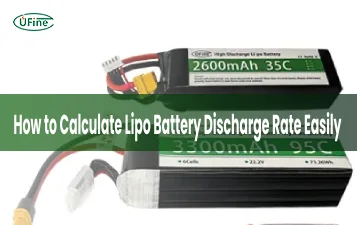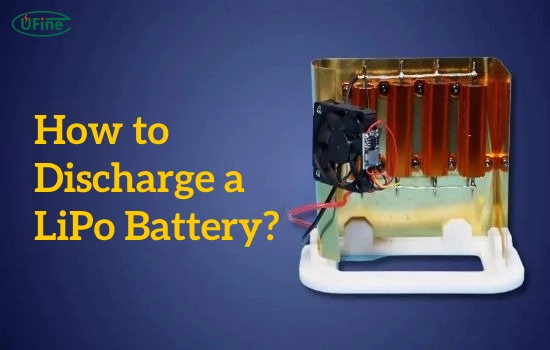How to discharge a LiPo battery? Safely discharging LiPo batteries is essential for maintaining their longevity and avoiding risks. Improper or excessive discharging can cause cell damage, shorten battery life, and lead to potential fire hazards or physical harm from hazardous materials or gases if the battery is damaged.
Part 1. LiPo battery discharge
Discharging LiPo batteries before storage or disposal is essential. Over time, if stored with a full charge, these batteries can self-discharge to a critical voltage, leading to irreversible damage. Over-discharging poses risks of cell damage, reduced capacity, or even rendering the battery unusable.
Part 2. How to manually discharge a LiPo battery?
Method 1: Using a Discharge Device
Specialized discharge devices offer controlled and efficient ways to discharge LiPo batteries safely. Follow these steps to use a discharge device:
- Connect the Battery: Ensure the discharge device is compatible with your LiPo battery. Connect the positive and negative terminals of the battery to the corresponding terminals on the discharge device.
- Set Discharge Parameters: Adjust the device’s discharge rate and cutoff voltage. The discharge rate should be within the battery manufacturer’s recommended range, typically between 1C and 3C, and set the cutoff voltage to a safe level.
- Monitor the Process: Start the discharge process and monitor the device throughout.Pay attention to unusual behavior, such as overheating or erratic voltage readings.Stop the process if any issues arise.
- Complete Discharge: The discharge process will stop automatically once the battery reaches the set cutoff voltage. Disconnect the battery from the device and ensure it’s at a safe voltage level for storage or disposal.
Method 2: Using a Resistor
Discharging a LiPo battery using a resistor requires careful calculation and monitoring.
- Select the Resistor: Choose a resistor with an appropriate resistance value to achieve the desired discharge rate. Use Ohm’s Law (V=IR) to calculate the resistance needed for the discharge current (I) based on the battery’s voltage (V) and desired discharge rate.
- Connect the Resistor: Connect the resistor to the positive and negative terminals of the LiPo battery. Ensure a secure connection to prevent any loose connections during the discharge process.
- Monitor Discharge: Monitor the voltage across the resistor continuously using a multimeter or voltage meter. Observe the voltage drop across the resistor as the battery discharges.
- Controlled Discharge: Adjust or disconnect the resistor once the battery voltage reaches the desired cutoff level to prevent over-discharging.
Method 3: Using a Light Bulb
Utilizing a light bulb as a discharge tool involves a simple setup.
- Select the Light Bulb: Choose a light bulb with appropriate wattage that aligns with the desired discharge rate. Higher-wattage bulbs will discharge the battery faster.
- Connect the Bulb: Connect the LiPo battery’s positive and negative terminals to the light bulb’s corresponding terminals. The bulb will act as a load, causing the battery to discharge through it.
- Observe Discharge: Monitor the light bulb’s brightness as the battery discharges. The brightness will decrease as the battery loses charge.
- End the Discharge: D disconnects the battery once the light bulb dims significantly or goes out. Ensure the battery voltage is at a safe level for storage or disposal.
These manual discharge methods require attention to detail and continuous monitoring to prevent over-discharging and ensure the safety of both the battery and the user.
Part 3. How to automatically discharge a LiPo battery?
Method 1: Using a Smart Discharger
Steps for Using a Smart Discharger:
- Compatibility Check: Ensure the intelligent discharger is compatible with your LiPo battery regarding voltage, capacity, and connector type.
- Setup: Following the manufacturer’s instructions, connect the LiPo battery to the intelligent discharger. Make sure all connections are secure.
- Adjust Settings: Set the desired discharge rate and cutoff voltage using the controls or interface provided by the intelligent discharger. Refer to the battery specifications for appropriate settings.
- Monitor the Process: Start the discharge process and monitor the tool’s display or indicators. Keep an eye on the progress to ensure it’s proceeding as intended.
- Completion and Safety: The smart discharger will typically stop automatically once the battery reaches the cutoff voltage. Disconnect the battery and confirm it’s at a safe voltage level for storage or disposal.
Method 2: Charger Discharge Feature
Steps for Using Charger Discharge Feature:
- Select Discharge Mode: Navigate through the charger’s menu or controls to find the discharge function.
- Set Parameters: Set the discharge rate and cutoff voltage per the battery manufacturer’s recommendations.
- Initiate Discharge: Start the discharge process through the charger’s interface and monitor the progress on the display.
- Completion: Once the discharge cycle completes and the battery reaches the cutoff voltage, the charger will typically signal or indicate the end of the process.
- Verify Safety: Disconnect the battery and confirm it’s at a safe voltage level for storage or disposal.
Part 4. Influence on LiPo battery discharge rate
Temperature
Temperature plays a critical role in affecting the discharge rate of LiPo batteries.
Low Temperatures:
- Reduced Discharge Rate: In colder environments, the discharge rate of LiPo batteries decreases significantly.
- Efficiency Impact: Lower temperatures slow down the chemical reactions within the battery, causing a decrease in overall discharge efficiency.
- Performance Impact: Batteries might not deliver their total capacity or appear to have lower voltage levels in colder conditions, impacting the discharge rate.
High Temperatures:
- Increased Discharge Rate: Conversely, higher temperatures accelerate the discharge rate of LiPo batteries.
- Potential Risks: High temperatures can increase the battery’s internal resistance, leading to faster discharge and potentially damaging the cells or reducing their lifespan.
- Safety Concerns: Extreme heat can pose safety hazards, potentially leading to thermal runaway or fire risks during discharge.
Battery Capacity
Battery capacity directly influences the discharge process of LiPo batteries.
Higher Capacity Batteries:
- Longer Discharge Time: LiPo batteries with higher capacities will take longer to discharge at the same discharge rate than lower-capacity batteries.
- Extended Usage: Higher capacity batteries can sustain more prolonged periods of use before needing recharging due to their increased energy storage.
Lower Capacity Batteries:
- Faster Discharge: Batteries with lower capacities discharge more quickly than higher-capacity batteries at the same discharge rate.
- Limited Usage Time: These batteries might require more frequent recharging due to their lower energy storage capacity.
Part 5. FAQs
-
How do you fully discharge a LiPo battery for disposal?
Discharging a LiPo battery for disposal should be done carefully to avoid safety risks. Connect a low-resistance load, like a bulb or resistor, to the battery until its voltage drops below 3V per cell. Then, follow proper disposal guidelines provided by local waste management facilities. -
How do you quickly discharge a battery?
A battery can be rapidly discharged by using a discharger specifically designed for batteries or by connecting a high-power resistor to it. However, this method may lead to safety risks and damage to the battery if not done correctly. -
What happens if you over-discharge a LiPo?
Over-discharging a LiPo battery below its recommended voltage can cause irreversible damage, cell imbalance, reduced capacity, and, in extreme cases, it may result in cell swelling, increased internal resistance, or even cell failure, rendering the battery unsafe and unusable. -
What is the best way to discharge a lithium-ion battery?
It’s best to discharge lithium-ion batteries to around 30-50% of their capacity before prolonged storage. Avoid deep discharges as they can adversely affect battery health. -
How low should I discharge a LiPo battery?
It’s advisable not to discharge a LiPo battery below 3V per cell to prevent damage. Operating the battery within its recommended voltage range helps maintain its health and longevity.
Related Tags:
More Articles

LiPo Battery Discharge Rate Guide & Calculation Tips
Understand LiPo battery discharge rates, C-ratings, and how to calculate max current. Essential guide for RC, drones, and electronics users.
High‑Capacity 3S LiPo Batteries: 5000 mAh vs. 10000 mAh
Compare 3S LiPo 5000mAh vs 10000mAh batteries by weight, power, and use. Find the best fit for your drone, RC car, or boat setup.
Top 5 Applications for Small 3S LiPo Batteries
Small 3S LiPo batteries power drones, RC gear, wearables, and robotics with high energy and low weight. Making them ideal for compact electronics projects.
Building and Charging Your Own 3S LiPo Pack: A Step‑by‑Step Guide
Learn how to build, balance, and charge a 3S LiPo battery pack safely at home with this complete DIY guide for hobbyists and beginners.
How to Choose the Right LiPo Battery Plug Type?
Discover the best LiPo battery plug types, how to choose them, and expert tips for safe usage, soldering, and maintenance.




